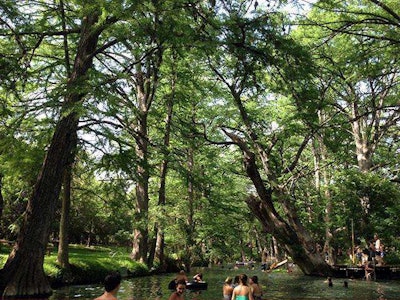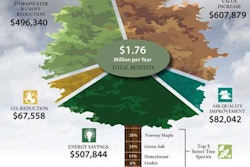 Blue Hole Regional Park
Blue Hole Regional ParkWimberley, Texas
Eight new projects have achieved certification in sustainable design, construction and maintenance of built landscapes.
Sustainable Sites Initiative (SITES) has announced that the eight projects have gained certification and are part of a group of 150 projects participating in a two-year, pilot program.
The program requires projects to meet the 2009 SITES guidelines and requirements for pilot certification.
The newly certified projects are:
- Blue Hole Regional Park in Wimberley, Texas
- Harris County WCID 132’s Water Conservation Center in Spring, Texas
- American University School for International Service in Washington, D.C.
- Bat Cave Draw and Visitor’s Center at Carlsbad Caverns National Park, New Mexico
- Mesa Verde Visitor and Research Center at Mesa Verde National Park, Colorado
- George “Doc” Cavalliere Park in Scottsdale, Arizona
- The National Renewable Energy Laboratory Research Support Facility in Golden, Colorado
- Scenic Hudson’s Long Dock Park in Beacon, New York.
In partnership with the American Society of Landscape Architects (ASLA), the Lady Bird Johnson Wildflower Center of The University of Texas at Austin and the United States Botanic Garden, SITES is designed to create guidelines and recognition for sustainable landscapes.
There are total of 23 certified pilot projects with more projects continuing to be completed until the end of 2014.
The new SITES v2 rating system will be published this fall. The projects certified up to that point qualified under the 2009 rating system. The rating system includes 15 prerequisites and 51 additional credits that add up to 250 points. The credits address areas like soil restoration, use of recycled materials and land maintenance approaches.
Blue Hole Regional Park, One Star, Wimberley, Texas. A local swimming hole was transformed into an environmentally sustainable regional park in the Texas Hill Country. Sustainable landscape strategies include managing storm- water through the use of rain gardens and cisterns, irrigating recreational fields with treated effluent, minimizing impervious surfaces, protecting trees and endangered species habitat and restoring shoreline. New vegetation is primarily native plantings, and the park features on-site composting.
Harris County Water Conservation and Improvement District (WCID) 132’s Water Conservation and Demonstration Center, One Star, Houston, Texas. WCID 132 created a community outreach project dedicated to showing alternative methods for reducing stormwater runoff and demand for potable water. This project transformed an under-used public campus into a series of gardens that educate residents on sustainable water use and landscape strategies. Features illustrate efficient water conservation, stormwater management and soil-centered practices. Paths and planting areas were built with locally salvaged and reused materials.
American University School for International Service, Two Stars, Washington, D.C. This entrance plaza is a gathering place for students and faculty that is integrated with a LEED Gold building to manage 100 percent of stormwater on the site and, as a result, needs no irrigation. The site features a Korean garden with adapted plants, an edible herb garden, an apiary and regional materials. The university has a zero-waste policy that includes recycling and composting landscape clippings and debris and coffee grounds from the student-run coffee shop inside.
Bat Cave Draw and Visitor’s Center, Two Stars, Carlsbad Caverns National Park, New Mexico. After finding contaminants from parking lot runoff, including motor oil and antifreeze, in cavern pools, Carlsbad Caverns National Park removed the existing parking area and rehabilitated it to a natural state using vegetation native to the park. All native plants used for the project were grown nearby from locally genetic stock, and additional work was done to collect and treat runoff from the new parking areas. The park near Carlsbad, New Mexico, was one of several parks that participated in a National Park Service pilot program to develop monitoring standards for re-vegetation.
Mesa Verde Visitor and Research Center, Two Stars, Mesa Verde National Park, Colorado. The site-sensitive landscape design surrounding the center reflects the national park’s mission to educate the public about the archeological, biological, and physical resources of the park and their interconnectivity. Stormwater from the site is directed through vegetated swales and retention ponds, and the area was re-vegetated with a mix of native and drought-tolerant species, meanwhile addressing concerns about wildfires. The site produces 95 percent of its energy from on-site renewable energy sources and uses locally quarried stone. The building has earned a LEED Platinum certification.
George “Doc” Cavalliere Park, Three Stars, Scottsdale, Arizona. A primary strategy for the park, located on 34 acres of rugged desert terrain, was the preserving and restoring of natural resources. The design uses 100 percent native plants, and all existing native trees, cacti, and plant communities were preserved in place or salvaged and re-used onsite to restore desert upland and riparian plant communities. The park also incorporates a regional on-site stormwater management system. Other strategies include rainwater collection, permeable paving in parking areas and driveways, high-efficiency LED lighting, net-zero energy consumption using a grid-tied 24 kilowatt solar photovoltaic system, and exclusive use of high-content recycled steel without industrial finishes.
National Renewable Energy Laboratory (NREL) Research Support Facility, Three Stars, Golden, Colorado. This federal research laboratory, a former National Guard training facility, consists of a 327-acre government research campus. The Research Support Facility, one of the newest campus additions, has achieved LEED Platinum certification for its innovative building design. The landscape framework for this net-zero energy facility includes establishing natural drainage for stormwater, minimizing impacts on local habitats, protecting habitat through conservation easements, providing hiking trails for staff and community members, using porous paving surfaces, restoring existing prairie and arroyo site features, using on-site materials for the construction of retaining walls, and installing energy-efficient lighting. Regional materials and high recycled content were emphasized in the selection of site materials and furnishings.
Scenic Hudson Long Dock Park, Three Stars, Beacon, New York. This project transformed a 14-acre property on the Hudson River from a degraded, post-industrial brownfield into a major waterfront park that realizes themes of recovery, remediation, reuse, and re-engagement. The project returned public access to the river, remediated contaminated soils, rehabilitated degraded wetlands, re-used found materials in innovative ways, and restored ecological diversity to upland, wetland, and intertidal zones. Features include decks and docks popular with anglers; ADA-accessible paths; areas for picnicking, river gazing, dog-walking, and Frisbee tossing; a kayak pavilion; and an outdoor classroom.










